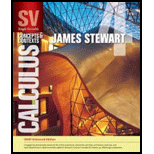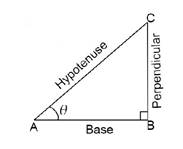
Concept explainers
To calculate: The point P on the line segment AB so as to maximize the angle θ .
Answer to Problem 57E
The point P be chosen on the line segment from the point B to x=4.50 unit.
Explanation of Solution
Given information:
A point P on the line segment AB
Formula used:
Trigonometric ratio:

tanθ=pb
Quadratic formula: let the
x=−b±√b2−4ac2a
Let f be a differentiable function defined on an interval I and let a∈I .
Then
- x=a is a point of local maximum value of f, if
- f′(a)=0 and
- f′(x) changes sign from positive to negative as x increases through a , i.e. if f′(x)>0 at every point sufficiently close to and to the left of a , and f′(x)<0 at every point sufficiently close to and to the right of a , then a is a point of local maxima
- x=a is a point of local maximum value of f, if
- f′(a)=0 and
- f′(x) changes sign from negative to positive as x increases through a , i.e. if f′(x)<0 at every point sufficiently close to and to the left of a , and at f′(x)>0 every point sufficiently close to and to the right of a , then a is a point of local minima.
- f′(a)=0 and If f′(x) does not change sign as x increases through a , then a is neither a point of local maxima nor a point of local minima.
Calculation:
As per the given problem
Draw the diagram of a point P on the line segment AB

Form the given figure the triangle △BPC makes the angle α and the triangle △APD makes the angle β
Here, it is observed that
θ=π−α−β
Recall that,
Trigonometric ratio: 5
tanθ=pb
tanα=2x and tanβ=53−x⇒α=tan−1(2x) and β=tan−1(53−x)
θ=π−tan−1(2x)−tan−1(53−x)
Recall that,
Let f be a differentiable function defined on an interval I and let a∈I .
Then
- x=a is a point of local maximum value of f, if
- f′(a)=0 and
- f′(x) changes sign from positive to negative as x increases through a , i.e. if f′(x)>0 at every point sufficiently close to and to the left of a , and f′(x)<0 at every point sufficiently close to and to the right of a , then a is a point of local maxima
- x=a is a point of local maximum value of f, if
- f′(a)=0 and
- f′(x) changes sign from negative to positive as x increases through a , i.e. if f′(x)<0 at every point sufficiently close to and to the left of a , and at every point sufficiently close to and to the right of a , then a is a point of local minima.
- f′(a)=0 and If f′(x) does not change sign as x increases through a , then a is neither a point of local maxima nor a point of local minima.
Differentiate with respect to x
θ′(x)=π−tan−1(2x)−tan−1(53−x) =−(11+4x2×−2x2)−(11+25(3−x)2×−5(3−x)2)
Solve for θ′(x)=0 , and simplified
−(11+4x2×−2x2)−(11+25(3−x)2×−5(3−x)2)=0⇒2x2+4+5x2−6x+34=0⇒5x2−6x+34=−2x2+4⇒−2x2+12x−68=5x2+20⇒7x2−12x−88=0
Recall that,
Quadratic formula: let the quadratic equation is ax2+bx+c=0,(a≠0) Thus, if b2−4ac≥0 then the roots of the quadratic equation is given by
x=−b±√b2−4ac2a
x=+12±√(−12)2−4×7×−882×7 =12±√144+246414 =12±√260814 =12±51.0614
Solve for different sign’s
x=12+51.0614 and x=12−51.0614 =4.50 and =−2.79
Because length can’t be negative,
Therefore,
x=4.50
Conclusion:
Thus the point P be chosen on the line segment from the point B to x=4.50 unit.
Chapter 4 Solutions
Single Variable Calculus: Concepts and Contexts, Enhanced Edition
- Consider the function f(x) = x²-1. (a) Find the instantaneous rate of change of f(x) at x=1 using the definition of the derivative. Show all your steps clearly. (b) Sketch the graph of f(x) around x = 1. Draw the secant line passing through the points on the graph where x 1 and x-> 1+h (for a small positive value of h, illustrate conceptually). Then, draw the tangent line to the graph at x=1. Explain how the slope of the tangent line relates to the value you found in part (a). (c) In a few sentences, explain what the instantaneous rate of change of f(x) at x = 1 represents in the context of the graph of f(x). How does the rate of change of this function vary at different points?arrow_forward1. The graph of ƒ is given. Use the graph to evaluate each of the following values. If a value does not exist, state that fact. и (a) f'(-5) (b) f'(-3) (c) f'(0) (d) f'(5) 2. Find an equation of the tangent line to the graph of y = g(x) at x = 5 if g(5) = −3 and g'(5) = 4. - 3. If an equation of the tangent line to the graph of y = f(x) at the point where x 2 is y = 4x — 5, find ƒ(2) and f'(2).arrow_forwardDoes the series converge or divergearrow_forward
- Suppose that a particle moves along a straight line with velocity v (t) = 62t, where 0 < t <3 (v(t) in meters per second, t in seconds). Find the displacement d (t) at time t and the displacement up to t = 3. d(t) ds = ["v (s) da = { The displacement up to t = 3 is d(3)- meters.arrow_forwardLet f (x) = x², a 3, and b = = 4. Answer exactly. a. Find the average value fave of f between a and b. fave b. Find a point c where f (c) = fave. Enter only one of the possible values for c. c=arrow_forwardplease do Q3arrow_forward
- Use the properties of logarithms, given that In(2) = 0.6931 and In(3) = 1.0986, to approximate the logarithm. Use a calculator to confirm your approximations. (Round your answers to four decimal places.) (a) In(0.75) (b) In(24) (c) In(18) 1 (d) In ≈ 2 72arrow_forwardFind the indefinite integral. (Remember the constant of integration.) √tan(8x) tan(8x) sec²(8x) dxarrow_forwardFind the indefinite integral by making a change of variables. (Remember the constant of integration.) √(x+4) 4)√6-x dxarrow_forward
 Calculus: Early TranscendentalsCalculusISBN:9781285741550Author:James StewartPublisher:Cengage Learning
Calculus: Early TranscendentalsCalculusISBN:9781285741550Author:James StewartPublisher:Cengage Learning Thomas' Calculus (14th Edition)CalculusISBN:9780134438986Author:Joel R. Hass, Christopher E. Heil, Maurice D. WeirPublisher:PEARSON
Thomas' Calculus (14th Edition)CalculusISBN:9780134438986Author:Joel R. Hass, Christopher E. Heil, Maurice D. WeirPublisher:PEARSON Calculus: Early Transcendentals (3rd Edition)CalculusISBN:9780134763644Author:William L. Briggs, Lyle Cochran, Bernard Gillett, Eric SchulzPublisher:PEARSON
Calculus: Early Transcendentals (3rd Edition)CalculusISBN:9780134763644Author:William L. Briggs, Lyle Cochran, Bernard Gillett, Eric SchulzPublisher:PEARSON Calculus: Early TranscendentalsCalculusISBN:9781319050740Author:Jon Rogawski, Colin Adams, Robert FranzosaPublisher:W. H. Freeman
Calculus: Early TranscendentalsCalculusISBN:9781319050740Author:Jon Rogawski, Colin Adams, Robert FranzosaPublisher:W. H. Freeman
 Calculus: Early Transcendental FunctionsCalculusISBN:9781337552516Author:Ron Larson, Bruce H. EdwardsPublisher:Cengage Learning
Calculus: Early Transcendental FunctionsCalculusISBN:9781337552516Author:Ron Larson, Bruce H. EdwardsPublisher:Cengage Learning





